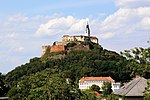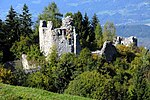Moosham Castle
- View a machine-translated version of the German article.
- Machine translation, like DeepL or Google Translate, is a useful starting point for translations, but translators must revise errors as necessary and confirm that the translation is accurate, rather than simply copy-pasting machine-translated text into the English Wikipedia.
- Do not translate text that appears unreliable or low-quality. If possible, verify the text with references provided in the foreign-language article.
- You must provide copyright attribution in the edit summary accompanying your translation by providing an interlanguage link to the source of your translation. A model attribution edit summary is
Content in this edit is translated from the existing German Wikipedia article at [[:de:Schloss Moosham]]; see its history for attribution. - You may also add the template
{{Translated|de|Schloss Moosham}}to the talk page. - For more guidance, see Wikipedia:Translation.
| Schloss Moosham | |
|---|---|
| Unternberg, Salzburg Austria | |
 Moosham Castle | |
| Type | Spur castle |
| Site information | |
| Owner | Private |
| Open to the public | Yes |
| Condition | Restored |
| Site history | |
| Built | c. 1191 |
Moosham Castle (German: Schloss Moosham) is a medieval castle near Unternberg in the Lungau region of Salzburg, Austria. The spur castle is situated at a height of 1,079 metres (3,540 ft).[1]
History


Possibly built on the foundations of a Roman castrum fortress, the castle was first documented in an 1191 deed. It was seized by the Prince-Archbishops of Salzburg about 1285 and from the 14th century onwards served as the residence of an episcopal burgrave. Under the rule of Prince-Archbishop Leonhard von Keutschach from 1495, the castle was rebuilt and extended. In 1520, it became an administrative seat of the Lungau region and was besieged during the German Peasants' War of 1524–25. Archbishop Wolf Dietrich Raitenau stayed here on his flight from Salzburg in October 1611, shortly before he was captured.
Moosham Castle served as the administrative center during the Zaubererjackl witch trials between 1675 and 1690. These trials led to the execution of 139 people. Unusually, most of those executed were male. Among those executed, 39 were children (between 10 and 14 years old), 53 were teenagers and young adults (between 15 and 21), 21 of unknown age; 113 were of male gender; everyone except two were beggars. The youngest was Hannerl, 10 years old, and the oldest was Margarethe Reinberg, 80 years old. 109 were executed during 1681. They were tortured and burned; some of them alive, others after having been hanged or decapitated – some of them after having had their hands cut off and marked with a burning iron.
Archbishop Count Hieronymus von Colloredo dissolved the Moosham bailiwick in 1790, whereafter the castle decayed. In 1886, the Austrian explorer and patron of the arts Count Johann Nepomuk Wilczek purchased the ruin and had it restored. Up to today, the complex is private property, though its rooms featuring Wilczek's extensive art collection are accessible to the public.
See also
- Burg Kreuzenstein
- List of castles in Austria
References
- ^ Moosham Castle Height and Location
Burgenland 






Carinthia Lower Austria Salzburg Styria Tyrol Upper Austria Vorarlberg
  | This article about a castle in Austria is a stub. You can help Wikipedia by expanding it. |
- v
- t
- e
 | This Salzburg state location article is a stub. You can help Wikipedia by expanding it. |
- v
- t
- e













